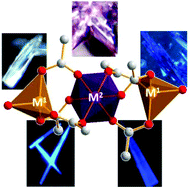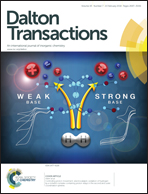Homo- and heterometallic luminescent 2-D stilbene metal–organic frameworks†
Abstract
Metal–organic frameworks (MOFs) can provide a matrix for the assembly of organic chromophores into well-defined geometries, allowing for tuning of the material properties and study of structure–property relationships. Here, we report on the effect of the coordinated metal ion on the luminescence properties of eight isostructural MOFs having the formula M12M2L3(DMF)2 (M1 = M2 = Zn (1), Cd (2), Mn (3), Co (4); M1 = Zn, M2 = Cd (5), Mn (6), Co (7); M1 = Co, M2 = Mn (8); L = trans-4,4′-stilbene dicarboxylate), synthesized by reaction of the appropriate metal nitrate or mixtures of metal nitrates with LH2 in DMF. The crystal structures of 2, 3 and 5–8 were determined by X-ray diffraction to be composed of trinuclear metal clusters linked by stilbene dicarboxylate linkers in a paddlewheel geometry, extending to form a 2-D layered structure. In the mixed-metal cases, the larger metal ion was found to occupy the octahedral site in the cluster while the smaller ion occupies the tetrahedral positions, suggesting a selective, ligand-directed assembly process for the mixed-metal species. Variable temperature magnetic measurements for paramagnetic MOFs 3 and 6–8 were consistent with the site occupancies determined crystallographically, and indicated weak intra-cluster antiferromagnetic coupling for 3 and 8. Comparison between the crystal structures of 2, 3 and 5–8 and those reported for 1 and 4 in the literature reveal close resemblances between linker environments, with important intermolecular stilbene–stilbene geometries that are comparable in all cases. Interestingly, pale-colored 1–3 and 5–7 display very similar emission profiles upon excitation at λex = 350 nm, whereas dark-colored 4 and 8 do not exhibit detectable emission spectra. The bright, well-resolved luminescence of 1, 2 and 5 is ascribed to rigidification of the linker upon coordination to the d10 metal ions, whereas the weaker emission observed for 3, 6 and 7 is presumably a result of quenching due to close proximity of the linker to one or more paramagnetic ions. Time-resolved measurements for 1, 2, 5 and 6 reveal biexponential emission decays, where the lifetime of the longer-lived state corresponds to observed variations in the nearest-neighbor cofacial stilbene–stilbene distances in their crystal structures. For 3, a monoexponential decay with shorter lifetime was determined, indicating significant paramagnetic quenching of its emissive state.


 Please wait while we load your content...
Please wait while we load your content...